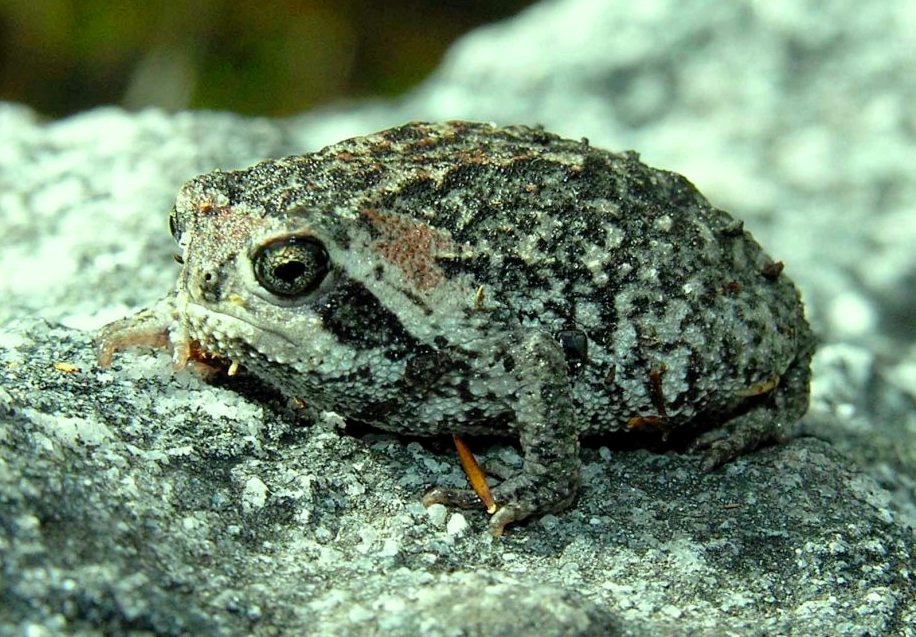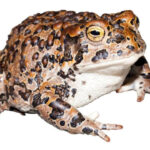Meet the Mountain Rain Frog: Discovering the Enigmatic Breviceps montanus#
Hidden away amidst the misty slopes and rocky mountain slopes of South Africa’s scenic peaks dwells an elusive yet captivating amphibian, the Mountain Rain Frog, scientifically known as Breviceps montanus. Small, round-bodied, and wonderfully adapted to a life quietly tucked away in cool, moist habitats, this frog is often overlooked but richly rewarding to anyone fortunate enough to learn of its remarkable existence.
Commonly dubbed as ‘rain frogs,’ these creatures have gained internet fame for their delightfully grumpy expressions and defensive puffing behavior. However, beneath that adorable façade lies a fascinating biology and ecology worth exploring. Rich in character, essential in ecological roles, and sensitive to environmental changes, Breviceps montanus holds particular significance in understanding how fragile ecosystems endure and adapt.
Taxonomy and Classification#
The Mountain Rain Frog belongs to the family Brevicipitidae, a group distinctively different from true frogs and toads due to unique physical characteristics and reproductive strategies. Within this family, the genus Breviceps accounts for a variety of compact, round-bodied frogs prevalent across Southern Africa.
First scientifically described by British zoologist John Hewitt in 1926, Breviceps montanus finds similarities and relations among other Breviceps frogs such as the Desert Rain Frog (Breviceps macrops) and Mozambique Rain Frog (Breviceps mossambicus). Despite these connections, the Mountain Rain Frog holds its distinct ecological niche and unique adaptations to life in higher altitudes.
Natural Habitat#
Nestled primarily within the lush mountain landscapes of the Western and Eastern Cape provinces of South Africa, Breviceps montanus inhabits altitudes ranging from approximately 800 to 1,800 meters above sea level. Breviceps montanus thrives specifically in montane fynbos and grasslands, habitats characterized by wet, mist-shrouded ecosystems that offer ideal moisture and shelter.
Mountain Rain Frogs favor habitats blanketed with thick vegetation, abundant leaf litter, and loose, sandy soil. They commonly inhabit areas beneath rocks, concealed amidst mossy crevices, or burrowing slightly into soft earth, all of which provide the moisture, cool temperatures, and essential protection these delicate amphibians need for survival.
The rich tapestry of fynbos and montane grasslands not only provides a refuge but also shelters a plethora of insects— the frog’s primary food source— facilitating a symbiotic environment where both the frog and its prey coexist in balance.
Physical Characteristics#
The Mountain Rain Frog’s appearance is immediately compelling. Often humorously described as “a grumpy avocado-sized earth potato,” its small yet rotund body measures approximately 40–60 millimeters in length. Its rounded form—almost spherical—is an adaptation ideal for its fossorial, partially subterranean lifestyle.
The coloration of this amphibian exhibits a remarkable range of earthy tones, varying from mottled shades of grey, brown, to olive-greenish hues, at times flecked with occasional dark spots or blotches. Such cryptic coloring allows these frogs superior camouflage amidst leaf litter, moss-covered rocks, and soil, effectively concealing them from predators.
Its short, robust limbs are designed for a life spent tunneling rather than leaping. Unlike the powerful leaps typically associated with other frog species, the Mountain Rain Frog employs a more humble, shuffle-like locomotion on sturdy, squat limbs, better suited for crawling through their mountainous domain.
Perhaps the frog’s most endearing trait is the characteristic facial expression. With large, dark, expressive eyes sitting atop an often grumpy-looking face, Breviceps montanus inadvertently captures the hearts of nature enthusiasts worldwide. Additionally, when threatened, it inflates its body rapidly, displaying a hilarious yet effective defensive posture intended to discourage would-be predators.
Behavior and Life Cycle#
Feeding Habits and Hunting Techniques#
Active predominantly during twilight hours or following the rainfall, the Mountain Rain Frog emerges from its hidden refuge to forage for food. Their diet mainly consists of ants, termites, small beetles, and other soft-bodied insects prevalent in their habitat. Like many amphibians, their sticky tongues rapidly shoot out to capture prey, making these small frogs surprisingly effective hunters within their microhabitat.
Intriguing Reproductive Behavior#
Among its most fascinating characteristics is how Breviceps montanus reproduces. Unlike typical frogs that lay eggs in water bodies, these frogs exhibit what scientists call “direct development.” They bypass the tadpole stage entirely, laying fertilized eggs in moist burrows or sheltered cavities within their habitat.
Mating typically occurs at the onset of the rainy seasons when males produce distinctive calls to attract females. Their call is less musical and more of a repetitive short chirp, often sounding like a gentle whistle echoing softly through their mountain habitat.
Once the female selects her mate, they lay eggs together in a carefully excavated chamber underground. Parental care, although limited, includes the initial protection provided by the sheltered burrow. Eventually, miniature froglets hatch, fully formed replicas of their parents, prepared to embrace the responsibilities of life outside their protective nest.
Ecological Role#
The seemingly modest Mountain Rain Frog plays a crucial ecological role within its specialized habitat. Primarily insectivorous, these frogs significantly influence local insect populations, helping naturally curb and control numbers, thus maintaining ecological balance within their delicate mountain ecosystem.
Likewise, Mountain Rain Frogs are critical prey items for snakes, larger amphibians, birds, and mammalian creatures that share their habitats. This predator-prey relationship forms a critical link in the food web, highlighting the inherent balance maintained in such specialized yet vulnerable environments.
Moreover, amphibians such as the Breviceps montanus act as key bioindicators—species whose presence, absence, and health reflect broader ecosystem health. Since their sensitive skin readily absorbs environmental contaminants, the declining population or health of these frogs would signal deteriorating environmental conditions or imbalances warranting attention and intervention.
Threats and Conservation Status#
Currently classified by the International Union for Conservation of Nature (IUCN) as Least Concern, the Mountain Rain Frog maintains relatively stable populations thanks to its remote and somewhat inaccessible habitat. However, ongoing vigilance is necessary, as even species categorized under Least Concern face potential stressors.
Primary threats and pressures include habitat degradation due to agricultural expansion, urban sprawl, invasive alien vegetation, climate change-related impacts (such as shifting weather patterns and reduced moisture availability), and associated habitat fragmentation limiting gene flow between populations.
Conservation initiatives focusing on preserving and restoring montane grasslands and fynbos habitats play a pivotal role in safeguarding the survival of this species. Local conservation groups and education programs continue tirelessly to highlight the importance of sustainable land use and environmentally-friendly farming practices to protect this unique amphibian.
Cultural and Scientific Significance#
Though seldom part of folklore or traditional symbolism compared to other more visible amphibians, the Mountain Rain Frog has gained contemporary recognition globally due to the widespread sharing of videos online showcasing their adorable defensive behaviors and charming expressions. Such attention, though whimsical, provides a valuable gateway toward deeper awareness and appreciation for amphibians and habitats critical to biodiversity.
Scientifically, Breviceps montanus contributes significantly to the study of amphibian adaptations to life outside traditional aquatic environments. Researchers focus on their unique reproductive behavior, skin adaptations to terrestrial life, and adaptive physiological strategies critical for comprehensive life-history understandings in ecological research.
Conclusion: Celebrating Nature’s Quiet Charmer#
The Mountain Rain Frog, Breviceps montanus, is much more than a small-bodied, grumpy-faced amphibian captivating the internet. Beneath its round, adorable exterior lies a fascinating creature deeply intertwined with South Africa’s montane ecosystems, essential ecological processes, and a profound scientific understanding of terrestrial amphibians.
Ensuring the continued wellbeing of this charming amphibian rests upon recognizing the vital importance and inherent fragility of the habitats they call home. Increased appreciation, awareness, and support for targeted conservation initiatives will secure a sustainable future for the Mountain Rain Frog and countless other species sharing their uniquely rich ecosystems.
Explore further, lend your voice to amphibian conservation, and help preserve not only Breviceps montanus but the vibrant and resilient tapestry of life which makes our natural world infinitely intriguing.












